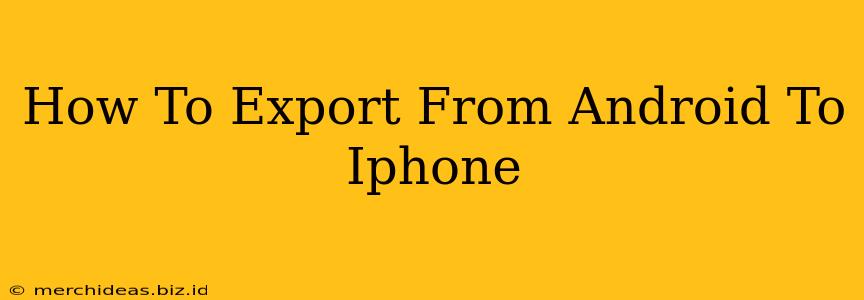Switching from Android to iPhone? The thought of transferring all your data can seem daunting, but it doesn't have to be! This comprehensive guide will walk you through the easiest and most efficient ways to export your data from your Android device to your new iPhone. We'll cover everything from contacts and photos to apps and messages, ensuring a smooth and stress-free transition.
Understanding Your Data Transfer Options
Before we dive into the specifics, let's outline the primary methods for transferring data from Android to iOS. Each method has its advantages and disadvantages, so choosing the right one depends on your specific needs and the amount of data you need to transfer.
1. Using Apple's "Move to iOS" App: The Official Method
This is Apple's recommended method and generally the easiest for a comprehensive transfer. The Move to iOS app directly transfers data wirelessly, minimizing manual effort. It's designed to handle a broad range of data types, including:
- Contacts: Your address book will be flawlessly transferred.
- Message History: Preserve your text conversations.
- Photos and Videos: Transfer your cherished memories.
- Calendar Events: Keep track of your appointments and reminders.
- Mail Accounts: Easily migrate your email accounts.
- App Data (some apps): Certain apps support data transfer via this method. However, note that not all apps offer this compatibility.
Advantages: Simple, straightforward process; handles a wide range of data; officially supported by Apple.
Disadvantages: Requires both devices to be on the same Wi-Fi network; not all apps support data transfer; may not transfer every single piece of data perfectly.
2. Manual Transfer: For Selective Data Migration
If you only need to transfer specific data types, a manual approach can be more efficient. This involves using cloud services, email, or other methods to move individual data points.
- Contacts: Export your contacts from your Android device as a .vcf file and import them into your iPhone's Contacts app. Many email clients also allow you to export contacts.
- Photos and Videos: Upload your photos and videos to cloud services like Google Photos, Dropbox, or iCloud, then download them to your iPhone.
- Files: Transfer files using cloud services or external storage like a USB drive.
- Music: Use music streaming services to access your library on your iPhone or download and transfer individual files.
Advantages: Greater control over what data is transferred; can be used for data that the "Move to iOS" app doesn't support.
Disadvantages: More time-consuming; requires a higher degree of technical knowledge; can be error-prone depending on your approach.
3. Third-Party Apps: Exploring Alternative Options
Several third-party apps offer data transfer services between Android and iOS. Research and choose a reputable app if you're looking for an alternative to Apple's official method or if you need more granular control over the transfer process.
Advantages: May offer features not available in other methods.
Disadvantages: Security concerns; reliance on third-party services; may require payment for full functionality.
Step-by-Step Guide: Using "Move to iOS"
Here's a step-by-step walkthrough using the Move to iOS app:
- Prepare your devices: Ensure both your Android device and iPhone are charged and connected to the same Wi-Fi network.
- Set up your iPhone: Begin the initial iPhone setup process. You'll reach a screen labeled "Apps & Data."
- Launch "Move to iOS" on your Android device: Download and open the app from the Google Play Store.
- Find the code: The iPhone will display a 10-digit code. Enter this code into your Android device.
- Select the data to transfer: Choose the data types you wish to transfer (contacts, messages, photos, etc.).
- Wait for the transfer to complete: This may take some time depending on the amount of data.
- Complete the iPhone setup: Once the transfer is complete, finish setting up your iPhone.
Troubleshooting Common Issues
- Slow transfer speed: Ensure both devices have a strong Wi-Fi connection.
- Transfer interruption: Keep both devices connected to power and Wi-Fi during the transfer process.
- Incomplete data transfer: Try restarting both devices and attempting the transfer again. You may need to transfer some data types manually.
By following these methods and tips, you can successfully transfer your data from Android to iPhone and enjoy a seamless transition to your new device. Remember to back up your data before starting the transfer process, just in case. Good luck!
